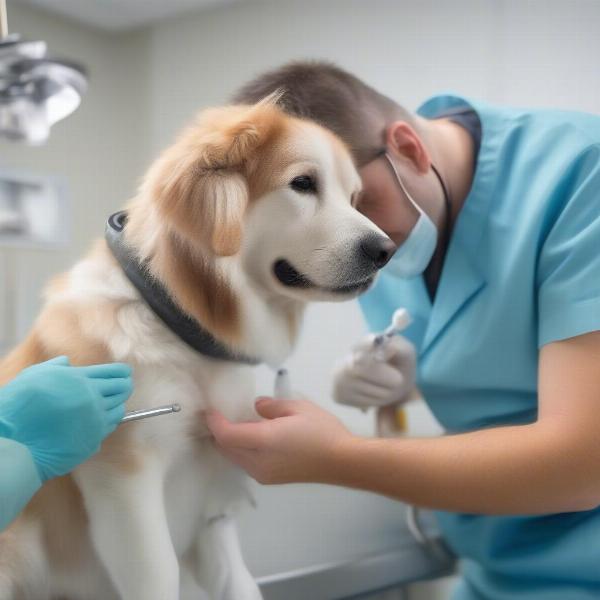Dog ear bleeding inside can be a frightening experience for any owner. Seeing blood coming from your furry friend’s ear naturally raises concerns. This article will explore the potential causes of internal ear bleeding in dogs, discuss treatment options, and guide you on when it’s crucial to seek immediate veterinary attention.
Understanding the Causes of Internal Ear Bleeding in Dogs
Several factors can contribute to bleeding inside a dog’s ear. These range from relatively minor issues to more serious medical conditions. Identifying the underlying cause is crucial for effective treatment. Common causes include ear infections, ear mites, foreign objects lodged in the ear canal, trauma to the ear (such as a bite or scratch), and even certain blood clotting disorders. Aural hematomas, which are blood-filled pockets that form within the ear flap, can also rupture and cause bleeding. Additionally, tumors within the ear canal, although less common, can also lead to bleeding.
Symptoms Accompanying Dog Ear Bleeding Inside
While the presence of blood is a clear sign, other symptoms can accompany internal ear bleeding and help pinpoint the cause. These might include head shaking, scratching at the ear, ear discharge (which may be bloody or pus-filled), whining or yelping in pain, a noticeable odor emanating from the ear, and tilting the head. In more severe cases, you might observe loss of balance, circling, or other neurological signs.
When to Seek Immediate Veterinary Attention
If you notice your dog’s ear bleeding inside, it’s essential to contact your veterinarian. While some causes are minor, others can be serious and require prompt treatment. Any signs of pain, discomfort, or neurological symptoms warrant immediate attention. Delayed treatment can lead to complications and potentially irreversible damage. Furthermore, if the bleeding is profuse or doesn’t stop within a short period, this is a medical emergency requiring immediate veterinary intervention.
 Dog Ear Cleaning at Vet
Dog Ear Cleaning at Vet
Treatment Options for Internal Ear Bleeding
Treatment for ear bleeding in dogs depends entirely on the underlying cause. Ear infections are typically treated with antibiotics (oral or topical), while ear mites require specific anti-parasitic medications. If a foreign object is present, the veterinarian will carefully remove it. Aural hematomas may require draining and surgical intervention to prevent recurrence. For more serious conditions like tumors, further diagnostics and specialized treatment, such as surgery or radiation therapy, may be necessary.
Preventing Ear Bleeding in Dogs
While not all causes of ear bleeding are preventable, some proactive measures can help minimize the risk. Regular ear cleaning with a veterinarian-approved solution can prevent infections and the buildup of debris. Checking your dog’s ears regularly for any abnormalities can also help detect problems early. Protecting your dog from ear trauma by supervising interactions with other animals and keeping their environment safe can also be beneficial. Furthermore, routine veterinary checkups are crucial for early detection of any potential ear problems.
Conclusion
Dog ear bleeding inside is a concerning symptom that should never be ignored. While some causes are relatively minor, others can be life-threatening. Prompt veterinary attention is crucial for accurate diagnosis and effective treatment. By understanding the potential causes, recognizing the accompanying symptoms, and seeking timely veterinary care, you can help ensure your dog’s ear health and overall well-being.
FAQ
-
What should I do if I see blood in my dog’s ear? Immediately contact your veterinarian for advice and schedule an examination.
-
Can I clean my dog’s bleeding ear myself? No, do not attempt to clean the ear yourself as this could worsen the condition. Let a veterinarian handle the cleaning.
-
Is dog ear bleeding inside always serious? Not necessarily, but it’s important to have it checked by a vet to rule out any serious underlying conditions.
-
How can I prevent my dog’s ear from bleeding? Regular cleaning, parasite prevention, and routine vet checks are key preventative measures.
-
What are the signs of a serious ear problem in dogs? Head shaking, persistent scratching, pain, discharge, odor, and loss of balance can all indicate a serious ear problem.
ILM Dog is your trusted resource for comprehensive information on dog care and well-being. We cover a wide range of topics, from breed selection and health care to training, nutrition, and grooming. Whether you’re a new dog owner or a seasoned enthusiast, ILM Dog offers expert advice and practical tips to help you provide the best possible care for your canine companion. For personalized guidance and support, contact us at [email protected] or call us at +44 20-3965-8624.